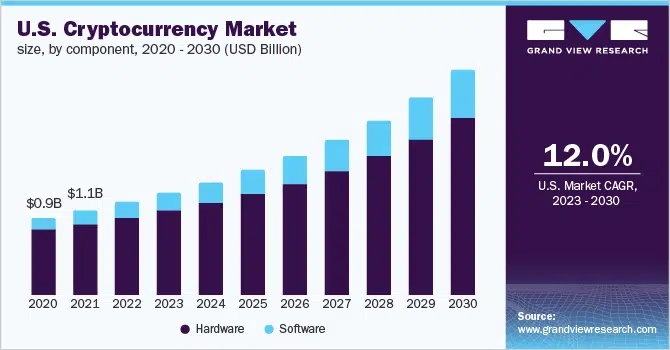Digital currencies are becoming popular daily, whether investing in crypto or trading. These currencies use encryption demand and supply currency units and verify fund transfers. They operate independently of a central bank.
In crypto investing, you purchase cryptocurrencies expecting the price to increase over time. In crypto trading, you take advantage of the market volatility by keeping your coins for a short time to maximize profit.
Different digital currencies exist, but Bitcoin is the most popular and valued. You can trade, invest, or do both in cryptocurrency. Both investing and trading often mean the same, but there are differences.
Forbes Advisor surveyed in the UK, and almost 67% agree that cryptocurrency is a legitimate investment (either strongly or somewhat agreeing with this statement).
Let’s learn the key differences between crypto trading vs crypto investing.
Understanding Crypto Trading
Like other financial assets, crypto trading involves predicting price movements and analyzing the future of Bitcoin and other digital assets. Crypto trading is all about buying or selling assets based on predictions of the best entry and exit points or “timing the market.” Crypto traders make their decisions by watching market news and technical analysis indicators.

Crypto traders employ some strategies and some of those strategies include:
Arbitrage
This trading strategy exploits the price differences of an asset on different crypto exchanges. Traders can take advantage of the small price differences for quick profits by buying and selling assets between exchanges.
Day Trades
Traders lock in profits and close their trades before dark by scanning the market for intraday price fluctuation. It takes from minutes to several hours for each operation.
Swing Trade
In a swing trade, the rapid fluctuations in the price of a crypto asset are where traders benefit from. A trade can last anywhere from a day to a few weeks. To identify significant directional movements in crypto prices over a short time, Swing traders employ technical analysis.
Position Trading
This is a form of trading that tends to reverse. Position trading is similar to swing trading, but a thorough study of long-term trends and patterns is necessary for position trading and can last from several months to a few years.
Scalping
Scalping is a high-frequency trading strategy in that traders can place multiple trades quickly to capture small price movements. Scalpers make quick trades with short wait times, taking minutes or even seconds in some cases to make a profit with minimal significant risk.
Heard about grid-trading bots? This exhaustive article explains how they work.
Benefits of Crypto Trading
In comparing crypto trading vs crypto investing, the main benefit of crypto trading is the potential to make quick profits by taking advantage of short-term movements and market trends.
Crypto assets were designed to function independently of central institutions; hence some crypto traders also value assets like BTC as a safe store of wealth.
Crypto assets can be traded peer-to-peer, with lower transaction fees than transactions involving central authorities such as banks and financial institutions.
Anyone with a mobile device or computer and an internet connection can create a crypto wallet and start trading since they are widely available.
Understanding Crypto Investing
Cryptocurrency investing is a long-term approach when compared to crypto trading and is sometimes called “HODLing” (a twist on the words “hold” and “hold on for dear life”). Crypto investors pay more attention to the core qualities of the crypto assets they buy instead of fixing their eyes on short-term market ups and downs.
Looking to understand more about what HODL means in the crypto world? This article is for you!
Below are the strategies used by crypto investors to navigate the market especially while determining Crypto Trading vs Crypto Investing.
Value Investing
Here, investors always look for cryptocurrencies with potential and solid fundamentals that are also undervalued. Value investors buy these assets when they’re low-priced and wait for their value to increase.
Growth Investing
Newer crypto assets with the potential to grow are focused on here. Investors take on more risk to see big returns on their investments.
Dollar-Cost Averaging
Small amounts of cryptocurrencies are bought by investors at regular intervals regardless of market fluctuations. Investors spread out their purchases and hope to average the prices as time goes on and minimize the impact of the market on their investment.
Index Fund Investing
Crypto index funds allow investors to invest in several digital currencies. This is similar to exchange-traded funds (ETFs) and mutual funds. These funds can help spread out the risk and provide more stable returns as they hold a mix of different assets.
Market Cap – Weighted Portfolio
You adjust your portfolio holdings periodically in this approach. Investors sell their cryptocurrencies whose value has increased and buy those at lower prices. Investors avoid over-concentration of a single digital currency and enhance the growth of their portfolio by implementing this strategy.
Benefits Of Crypto Investing
The potential for your investment to grow over time is one of the most significant benefits of cryptocurrency investing. Historical data shows the cryptocurrency market has experienced rapid growth in the past decade amidst price fluctuations and market sentiment. Crypto investors can profit from this growth in the long term.
Cryptocurrencies can hedge against inflation, another advantage of investing in cryptocurrencies. Cryptocurrency prices tend to be more resistant to changes in market sentiment, unlike fiat currencies. With this, investors can protect their assets from inflation and diversify their investment portfolio.
Also, crypto investing focuses on long-term commitment to the market and involves lower risks than crypto trading. Investors reduce their exposure to short-term volatility faced by crypto traders by taking a more patient and strategic approach.
Key Differences Between Crypto Trading vs Crypto Investing
In comparing crypto trading vs crypto investing, one can see that they come hand-in-hand despite their differences. Crypto investors can be traders, and traders can also be investors. However, knowing the key differences between crypto trading vs crypto investing is still important, especially for those looking to start their journey into the crypto market.
Here, we’ll outline the key differences between crypto trading vs crypto investing.
Profit Potential
Crypto investors profit majorly when the price increases, with gains calculated as the difference between the selling and buying prices minus the cost of investment (e.g., trading fees).
Additionally, crypto investors can benefit from airdrops, staking, and yield farming, and this is typically unavailable to crypto traders because they hold their digital assets for a short time.
Crypto traders profit from market fluctuations and leverage their trades to amplify profits with minimal initial capital. It is worth noting that leverage also increases risk. Crypto traders can profit in a bull or bear market, unlike crypto investors, who may have to wait out the bear market.
Risk
In comparing crypto trading vs crypto investing, crypto investors are less concerned with daily price fluctuations and tend to have a lower risk tolerance, focusing on long-term growth. Crypto traders, on the other hand, are risk-takers with a good understanding of market volatility.
Crypto traders study indicators and signals to make trades that capitalize on short-term price swings. Crypto traders may also engage in margin trading, which involves borrowing funds to trade, increasing potential profits and risks.
Investment Time Frame and Period
Crypto investors are typically involved in a long-term outlook, focusing on their chosen cryptocurrencies’ future potential and price appreciation. They are unaffected by short-term price fluctuations and hold their assets for extended periods and sometimes years.
Crypto trading, on the other hand, is a short-term strategy focusing on the extreme volatility of digital currencies. Traders make significant profits because of the volatility of cryptocurrencies as they speculate on price movements within various time frames, from seconds to weeks.
Type of Analysis
Crypto investors carry out fundamental analysis, thereby assessing the long-term value of a digital currency based on its underlying technology, adoption rate, and potential use cases. The absence of a financial statement shows this differs from traditional stock analysis.
Cryptocurrency traders rely heavily on technical analysis to predict future price trends and market positioning. To make informed decisions and profit from price volatility, traders use historical data, technical indicators, and charting tools.
Trade Frequency
Crypto investors hold their assets for extended periods without selling and typically have a low trading frequency. They aim to accumulate wealth over time and are less affected by short-term market volatility.
Conversely, crypto traders execute trades more frequently to take advantage of market movements to make substantial gains. More risks are involved in this approach, requiring continuous market monitoring and incurring higher costs due to the number and frequency of trades.
Mistakes can be costly in the crypto market. Here are 8 common trading mistakes to avoid.
Conclusion
The crypto market is growing, leading to new economic choices and decisions. Crypto trading vs crypto investing has its unique and peculiar benefits.
Understanding the key differences between crypto trading vs crypto investing is crucial before deciding which approach suits you best.
Crypto traders profit from short-term price movements in a bull or bear market. To take advantage of market conditions, smart investors recognize the different parts of market cycles and HODL in the hope that the price of assets will increase.
Crypto trading vs crypto investing has been insightful but If you are looking to earn with crypto other than trading or investing you must explore cloud mining, crypto mining, staking, crypto lending, and yield farming.




















